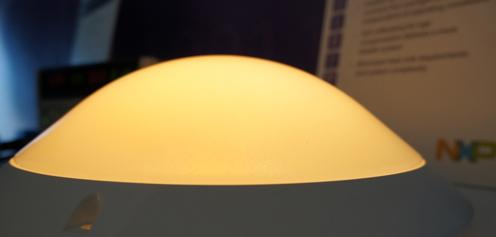 The light quality of an LED is significantly different from that of an incandescent lamp: the LED lamp is “cooler†than the incandescent lamp when it is dimmed. At the 2013 International Consumer Electronics Show held last week, NXP Semiconductors (Nasdaq: NXPI) demonstrated a breakthrough solution through which LED lamps can mimic the traditional incandescent lamp When it is dark, it can produce warmer and more comfortable white light. In addition to the "sensorless sensing" technology developed and patented by NXP, the benefits of this solution include the elimination of the use of an external temperature sensor, reducing the cost of the LED system, reducing the size of the heat sink needed to cool the LED system, and Significantly improve reliability.
The light quality of an LED is significantly different from that of an incandescent lamp: the LED lamp is “cooler†than the incandescent lamp when it is dimmed. At the 2013 International Consumer Electronics Show held last week, NXP Semiconductors (Nasdaq: NXPI) demonstrated a breakthrough solution through which LED lamps can mimic the traditional incandescent lamp When it is dark, it can produce warmer and more comfortable white light. In addition to the "sensorless sensing" technology developed and patented by NXP, the benefits of this solution include the elimination of the use of an external temperature sensor, reducing the cost of the LED system, reducing the size of the heat sink needed to cool the LED system, and Significantly improve reliability. The light color of an incandescent lamp becomes warmer and more exotic when it is darker and less bright. In contrast, today's LED lights are generally less light-colored than traditional light bulb users in the entire dimming range.
To emulate incandescent bulbs when the LEDs are dimmed, the NXP solution integrates three key functions into the drive circuit:
Combines white LED and amber LED to form the most pleasing light color (along black body radiation curve) in a cost-effective way
Logarithmic correction of eye sensitivity with an analytical model that allows the desired light color point to be achieved when darkening uses sensorless sensing technology to directly measure LED junction temperature, enabling accurate and efficient real-time temperature correction, which under any conditions Reliable control of LED performance is critical Regardless of the LED's operating time, smart LED drivers developed by NXP enable stable color and light output at any temperature. Sensorless sensing directly measures the LED junction temperature by connecting two existing wires of the LED, which solves the challenge of LED temperature drift and has more advantages than traditional LED temperature measurement methods. The use of sensorless sensing eliminates the need for external sensors or wiring, thereby reducing the total number of components and enabling a more compact heat sink. In addition, sensorless sensing enables fast performance, accurate temperature measurements (~1°C res.), dynamic light control, freedom from heat sinks and operating conditions, no thermal modeling, and self-calibration to compensate for time of use.
Michael Bruno, senior director of advanced technology and future innovation business development at NXP Semiconductors, said: “Our research team has initiated the initiative to answer this question: What will inspire consumers to accept LED lighting with the same emotion as an incandescent lamp? With sensorless Sensing technology, we demonstrated a new approach to incandescent-related warm light by using dimmable LED lights. Sensorless sensing also helps reduce overall system cost by eliminating the need for fewer components. Another major obstacle to widespread use of LEDs is the clever method that significantly improves the reliability and longevity of LEDs, so sensorless sensing has great potential in other areas such as automotive SSL and commercial LED applications."
Encoding disk refers to a digital encoder that measures angular displacement. It has the advantages of strong resolving power, high measurement accuracy and reliable work. It is one of the most commonly used displacement sensors for measuring the position of the shaft rotation angle. The code disk is divided into two types: absolute encoder and incremental encoder. The former can directly give the digital code corresponding to the angular position; the latter uses a computing system to make the pulse increment generated by the rotating code disc against a certain reference number addition and subtraction. The metal encoding disk is directly engraved with through and unconnected lines, and it is not fragile, but because the metal is not easy to corrode but easy deform, the accuracy is limited, and its thermal stability is an order of magnitude worse than that of glass. It is mainly used in motor, hardware, electrical appliances, automobile and other fields.
We customize diverse patterns metal encoder disk with drawings provided by customers. We are equipped with professional metal etching equipment and exposure development equipment. The raw material use for encoder disk are SUS304 stainless steel and the flat degree can below 0.02 mm. Our stainless-steel encoder disk can achieve flat, no burr and can be available in harsh environment.
Stainless Steel Encoder Disk,Encoder Disk,Metal Encoding Disk
SHAOXING HUALI ELECTRONICS CO., LTD. , https://www.cnsxhuali.com